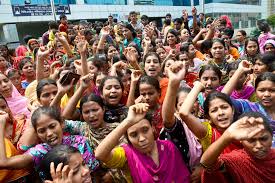
Why is it when women jumped to their deaths to escape the deadly fire in the Triangle Shirtwaist Factory in New York City in 1913, we are even today able to be horrified at the management’s cold blooded view of workers as expendable? But why is it we are not as enraged when hundreds of women were killed in the April 2013 Rana Plaza Factory fire in Bangladesh? Even when we know that the workers were making products for Disney and Walmart, why aren’t we horrified? Shouldn’t we be enraged that workers anywhere are killed because of lack of safety standards, regardless of which company they are working for, whether it is a multinational company or a local company? Once we put an American face on the sweatshop, one hopes that will generate some amount of questioning, such as why Walmart has not followed safety standards in Bangladesh, what companies are overlooking safety regulations, why they are exempt from local laws regarding worker safety, and so on. More importantly, when we see advertisements showing how most of us profit from shopping in Walmart because of their low prices, shouldn’t we be asking how we are implicated in Walmart’s ability to keep prices low? Who benefits? At whose expense are we enjoying bargains? But, perhaps, we are so conditioned by the system of consumption, where the ideal customer is often confused with the ideal citizen, that we do not see the shadows of workers behind the aisles of clothing or behind the glass cases holding our electronic gadgets.
The worker has become as intangible to us as a theorem or a cosmic body. How can we see/feel/touch/hear/smell workers in the business of making our life livable?
Once the American consumer is able to SEE the connection between his/her “deals” and “specials” and the masses of brown, malnourished women working in unsafe factories making the goods that flood markets in the U.S., the consumer will become informed and this would be the beginning of addressing the rights of both the worker and the consumer. But this connection cannot be established if the consumer is not really given the full “news” about the conditions of workers. Just as we know so little about the wars in Iraq and Afghanistan, we do not have complete knowledge about sweatshop atrocities. The news media has not shared with the American public images of sweatshop workers dying and injured in the Bangladesh factory fire. As Amy Goodman says in an interview about the American wars in Iraq and Afghanistan, if Americans were to see graphic pictures of war, they will urge their government toward other means of resolving conflict. Images of workers’ in unsafe conditions will have the necessary effect on consumers, which will then propel companies to act and governments to enforce laws protecting workers. It is a shame that the U.S. multinational companies can shelter under the very laws that are meant to protect workers.
Elizabeth Cline points out, “In 2009, the Ninth US Circuit of Appeals ruled that workers in foreign factories that supply Walmart can’t hold the company responsible for their workplace conditions, despite the retailer’s code of conduct that’s supposed to hold its contractors to decent labor standards. This lack of liability is enjoyed by every retailer that uses contracted factories, which they do not own. It’s this loophole, the one that legally distances clothing companies from the very people who actually make the clothing, that has consistently and historically wrought disaster and human tragedy. This chilling othering of the worker makes us lose our very humanity.
We can create a movement by posting images of atrocities as a way of mobilizing the public to stand up against a greedy capitalism that is eroding both worker rights and our rights as citizens. It is time to say, we are global citizens, not consumers. It is time to claim our humanity.
(Photo Credit: Trusted Clothes)
